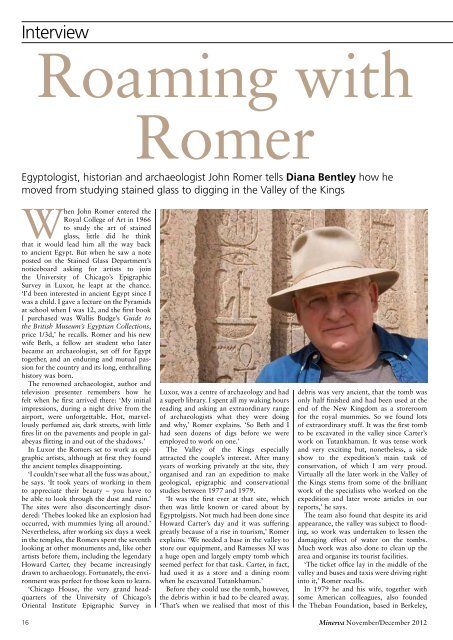Following Odysseus Not the end of the world Amarna city of light ...
Following Odysseus Not the end of the world Amarna city of light ...
Following Odysseus Not the end of the world Amarna city of light ...
- No tags were found...
You also want an ePaper? Increase the reach of your titles
YUMPU automatically turns print PDFs into web optimized ePapers that Google loves.
InterviewRoaming withRomerEgyptologist, historian and archaeologist John Romer tells Diana Bentley how hemoved from studying stained glass to digging in <strong>the</strong> Valley <strong>of</strong> <strong>the</strong> KingsWhen John Romer entered <strong>the</strong>Royal College <strong>of</strong> Art in 1966to study <strong>the</strong> art <strong>of</strong> stainedglass, little did he thinkthat it would lead him all <strong>the</strong> way backto ancient Egypt. But when he saw a noteposted on <strong>the</strong> Stained Glass Department’snoticeboard asking for artists to join<strong>the</strong> University <strong>of</strong> Chicago’s EpigraphicSurvey in Luxor, he leapt at <strong>the</strong> chance.‘I’d been interested in ancient Egypt since Iwas a child. I gave a lecture on <strong>the</strong> Pyramidsat school when I was 12, and <strong>the</strong> first bookI purchased was Wallis Budge’s Guide to<strong>the</strong> British Museum’s Egyptian Collections,price 1/3d,’ he recalls. Romer and his newwife Beth, a fellow art student who laterbecame an archaeologist, set <strong>of</strong>f for Egypttoge<strong>the</strong>r, and an <strong>end</strong>uring and mutual passionfor <strong>the</strong> country and its long, enthrallinghistory was born.The renowned archaeologist, author andtelevision presenter remembers how hefelt when he first arrived <strong>the</strong>re: ‘My initialimpressions, during a night drive from <strong>the</strong>airport, were unforgettable. Hot, marvellouslyperfumed air, dark streets, with littlefires lit on <strong>the</strong> pavements and people in galabeyasflitting in and out <strong>of</strong> <strong>the</strong> shadows.’In Luxor <strong>the</strong> Romers set to work as epigraphicartists, although at first <strong>the</strong>y found<strong>the</strong> ancient temples disappointing.‘I couldn’t see what all <strong>the</strong> fuss was about,’he says. ‘It took years <strong>of</strong> working in <strong>the</strong>mto appreciate <strong>the</strong>ir beauty – you have tobe able to look through <strong>the</strong> dust and ruin.’The sites were also disconcertingly disordered:‘Thebes looked like an explosion hadoccurred, with mummies lying all around.’Never<strong>the</strong>less, after working six days a weekin <strong>the</strong> temples, <strong>the</strong> Romers spent <strong>the</strong> seventhlooking at o<strong>the</strong>r monuments and, like o<strong>the</strong>rartists before <strong>the</strong>m, including <strong>the</strong> leg<strong>end</strong>aryHoward Carter, <strong>the</strong>y became increasinglydrawn to archaeology. Fortunately, <strong>the</strong> environmentwas perfect for those keen to learn.‘Chicago House, <strong>the</strong> very grand headquarters<strong>of</strong> <strong>the</strong> University <strong>of</strong> Chicago’sOriental Institute Epigraphic Survey in16Luxor, was a centre <strong>of</strong> archaeology and hada superb library. I spent all my waking hoursreading and asking an extraordinary range<strong>of</strong> archaeologists what <strong>the</strong>y were doingand why,’ Romer explains. ‘So Beth and Ihad seen dozens <strong>of</strong> digs before we wereemployed to work on one.’The Valley <strong>of</strong> <strong>the</strong> Kings especiallyattracted <strong>the</strong> couple’s interest. After manyyears <strong>of</strong> working privately at <strong>the</strong> site, <strong>the</strong>yorganised and ran an expedition to makegeological, epigraphic and conservationalstudies between 1977 and 1979.‘It was <strong>the</strong> first ever at that site, which<strong>the</strong>n was little known or cared about byEgyptolgists. <strong>Not</strong> much had been done sinceHoward Carter’s day and it was sufferinggreatly because <strong>of</strong> a rise in tourism,’ Romerexplains. ‘We needed a base in <strong>the</strong> valley tostore our equipment, and Ramesses XI wasa huge open and largely empty tomb whichseemed perfect for that task. Carter, in fact,had used it as a store and a dining roomwhen he excavated Tutankhamun.’Before <strong>the</strong>y could use <strong>the</strong> tomb, however,<strong>the</strong> debris within it had to be cleared away.‘That’s when we realised that most <strong>of</strong> thisdebris was very ancient, that <strong>the</strong> tomb wasonly half finished and had been used at <strong>the</strong><strong>end</strong> <strong>of</strong> <strong>the</strong> New Kingdom as a storeroomfor <strong>the</strong> royal mummies. So we found lots<strong>of</strong> extraordinary stuff. It was <strong>the</strong> first tombto be excavated in <strong>the</strong> valley since Carter’swork on Tutankhamun. It was tense workand very exciting but, none<strong>the</strong>less, a sideshow to <strong>the</strong> expedition’s main task <strong>of</strong>conservation, <strong>of</strong> which I am very proud.Virtually all <strong>the</strong> later work in <strong>the</strong> Valley <strong>of</strong><strong>the</strong> Kings stems from some <strong>of</strong> <strong>the</strong> brilliantwork <strong>of</strong> <strong>the</strong> specialists who worked on <strong>the</strong>expedition and later wrote articles in ourreports,’ he says.The team also found that despite its aridappearance, <strong>the</strong> valley was subject to flooding,so work was undertaken to lessen <strong>the</strong>damaging effect <strong>of</strong> water on <strong>the</strong> tombs.Much work was also done to clean up <strong>the</strong>area and organise its tourist facilities.‘The ticket <strong>of</strong>fice lay in <strong>the</strong> middle <strong>of</strong> <strong>the</strong>valley and buses and taxis were driving rightinto it,’ Romer recalls.In 1979 he and his wife, toge<strong>the</strong>r withsome American colleagues, also founded<strong>the</strong> Theban Foundation, based in Berkeley,Minerva November/December 2012
















